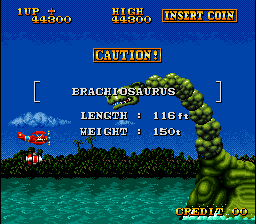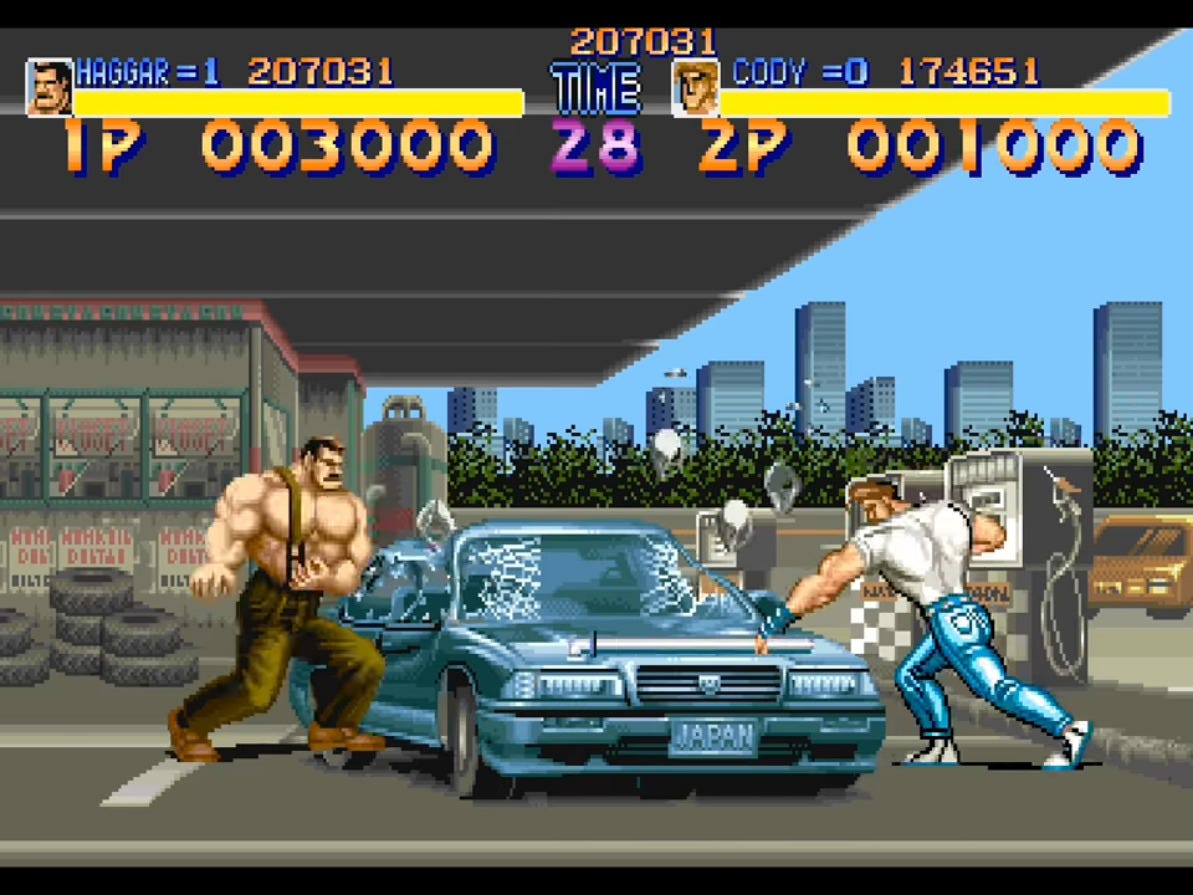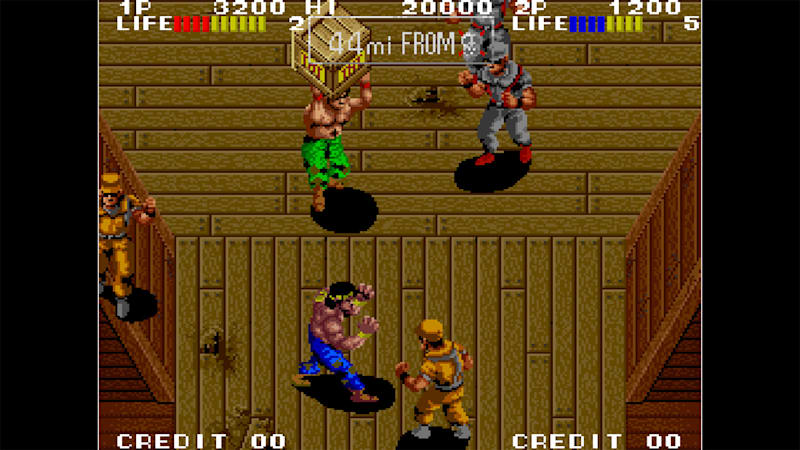It’s 1989 and even though it hasn’t hit the start of the next decade, you might consider this year to be 90s as hell. 1989 is when a lot of cornerstones of the era got their start as they continued into the next decade. Tim Burton’s Batman movie changed the way people looked at comic book movies and a few years later lead to the creation of Batman: The Animated Series.
Disney’s The Little Mermaid hit theaters, leading to what is called the Disney Renaissance with several more iconic animated movies from the company in the following years. In gaming, one of the games I’ll be looking at, Final Fight, also set a standard for beat-em-ups of the 90s. It was the transitionary period to the new decade and both Capcom and SNK brought both their A-games and B-games. Let’s see who comes out on top!
Ikari Warriors 3(SNK): The president’s daughter has been kidnapped and since this is an emergency situation, the
The actual game is a noticeable improvement over P.O.W. The graphics and sounds are far better and more satisfying and there’s a bit more to the controls thanks to jumping and a back punch. The enemy variety is still pretty dire, but at least there’s more than 4 different kinds this time. It does a passable job as a beat-em-up for the time, with punchy sound effects and some weapons to spice things up, but unfortunately there’s one thing that ruins it: the fucking timer.
Through the entire game, there is a timer (the “distance gauge”) constantly counting down and only goes up by small increments when you advance in the map. Enemies do not go down fast, especially not when they’re stun locking you to death, and if that timer runs out, you start the level from the beginning! Getting to the end of the stage in the time limit given becomes impossible unless… Well, the following quote from Hardcore Gaming 101 explains:
"Here’s the funny thing: If you have less than 25m on the distance gauge, dying and then continuing will recharge it to 25m! Unless you can beat up all enemies inhumanly quickly, repeatedly dying and continuing to replenish the timer is the only way to get through levels and end this game! It’s more of a danger to actually stay alive and have the enemy capture you. SNK actually invented a new, immoral way of to make players use up credits.”
That is probably the single most idiotic, cockamamie, counter-intuitive thing I have ever seen in an arcade game! It is a game where you need to make dying an important part of winning because they couldn’t be bothered to balance it! Epic fail! At least Capcom knows better!
Rally 2011 LED Storm(CAP): Capcom does not know better. Just like Ikari Warriors 3, this top-down racing game runs on a time limit in the form of fuel. You have to keep collecting fuel on the track as you race in order to make it to the end of each level and if you run out you are booted back to the start of it. Fuel is far more scarce than it should be and the canisters you pick up won’t last you very long, meaning there is very little margin of error and if you whizzed by a canister because it was on the opposite side of the track because you had no idea where it’d be, you’re probably boned. Unlike Ikari Warriors 3, your fuel keeps going down even when you are slowly brought back after crashing, making it even worse, from a certain point of view.
There isn’t even enough payoff to make it worth that frustration. LED Storm is very average, not utilizing the new CPS board for much other than voice samples from your talking computer assistant. Every track is just a texture swap and not even the transforming vehicle mechanic amounts to much. This game kind of blows.
Strider(CAP): It’s been a while since the last action platformer, but not much has improved. The main character, Hiryu, gets a lot out of his one jump button, able to climb and clamber on virtually any surface plus do a slide on the ground, but the level design doesn’t do a lot with that and many times starts to approach Ghosts n’ Goblins levels of difficulty with its cheap shots and enemy placement. It tries to tell a story to keep you interested, but all the characters in it have no character traits whatsoever and cutscenes are brief. There’s simply nothing that motivates me to play it. Even before this I played Strider at an arcade and got sick of it fairly quick. It’s bland and mediocre.
Dynasty Wars(CAP): That’s weird. I thought this was a Tecmo Koei game. Dynasty Wars makes some significant improvements to set it apart from the beat-em-ups I’ve looked at so far. You can attack in 2 directions, giving it the sort of twin-stick strafing feel of previous shooter games, and each attack can be both used for rapid attacks and charged for a stronger, longer-reaching attack. At the cost of some vitality you can also use several different enemy-wiping special attacks. This all seems simple, but in the heat of the moment you have to take into consideration whether a charged attack or rapid attack works better for the ways enemies are positioned and if the cost of using the special attack is less than what you would lose dealing with enemies the old-fashioned way.
 |
| No slowdown or flickering, though I'm not playing on the original hardware. |
Curiously, being based on a Shonen Jump manga, this is one of the few licensed games I’ve looked at. There have been a few licensed games from both companies up to this point that I’ve had to skip either because they’re console games, they never got a re-release for probably legal reasons, or both. Since this manga is an obscure one from the 80s and had a short run, I would imagine it wasn’t much of a hassle getting the rights to re-release it.
Prehistoric Isle in 1930(SNK): SNK clearly saw what Capcom’s big weapon was doing so they upped their graphical fidelity accordingly for this game. The sprite work and smooth animations on some of the enemies look gorgeous for the time and the game itself is a solid shoot-em-up with a unique swiss-army secondary weapon and several different distinct dinosaur bosses.
 |
| Each boss gets a little stats screen. |
Willow(CAP): Like I stated regarding Dynasty Wars, licensed
games aren’t as likely to get re-releases, so ordinarily I would skip this one
because it’s a good example, but recall the introductory post to this whole
series when I said I had access to several arcades within driving distance. One of those locations just happened to have
It’s a shame that this
 |
| The final level can be grating, however. |
Certain aspects of it would be seen in later SNK games so I get why the anniversary collection made it playable for the sake of historical curiosity, but I think even the guys at Digital Eclipse know it’s trash. It’s still better than Street Fighter 1 though, because at least it looks and sounds pretty good, if nothing else.
Beast Busters(SNK): This game is available in the SNK 40th
Anniversary collection, where you can use a controller to aim, but as you might
expect, it’s not quite the same as the lightgun cabinet it was made for. It wouldn’t be so bad if the decided method
of control wasn’t centering the aiming automatically when the control stick
isn’t being touched and if you don’t like that, like me, you can’t change it. I could settle for using the mouse like in
other modern day rail shooter ports, but I guess Digital Eclipse didn’t bother
to program that just for this one game.
Lucky me then that the same arcade
 |
| Now that's a cabinet. |
Final Fight(CAP): When it comes to the beat-em-up, this and Streets of Rage later on are the two most influential and often-cited in the genre. There had been ones before Final Fight to varying success, but this one set a standard that other games would follow and not without good reason. The act of beating up thugs and watching them fall down and go flying is made satisfying thanks to the solid audio and visual design. The sound of smacking and yelling over the grungy panoramic backgrounds come together to suck you into the moment.
 |
| The car-crushing minigame gives a little break from all the standard beatdowns. |
S.A.R.: Search and Rescue(SNK): This is SNK’s last loop
lever shooter and it does not go out with a bang. It doesn’t go out on a whimper either, but
it’s derivative. This game was designed
after watching Aliens and playing Contra.
Room after room you messily shoot down infected humans and creepy aliens, including legally distinct Xenomorphs, as the environments get progressively
more organic. Apart from gooey alien
visuals not much makes it stand out from Guerilla War or
The Winner
The winner of this year is close. Both companies had their share of big hits
and misses. SNK had some greats like
Prehistoric Isle and Beast Busters while Capcom had
With S.A.R. I have officially played all the arcade games from the SNK 40th Anniversary Collection. There’s still one or two console ports on it for 1990, but no more arcade games. Did they give up? Did SNK stop making arcade games? Has Capcom ultimately won in the long run or is SNK preparing something big? Something that would turn everything around? A weapon to surpass Metal Gear?! Well there’s going to be another post after this, so maybe. Get ready for next time when the 90s officially begin.


No comments:
Post a Comment